4.5 metal cast clasps
1/76
There's no tags or description
Looks like no tags are added yet.
Name | Mastery | Learn | Test | Matching | Spaced |
|---|
No study sessions yet.
77 Terms
what is direct retainer?
component of partial removable dental prosthesis used to retain and prevent dislodgment, consisting of a clasp assembly or precision attachment
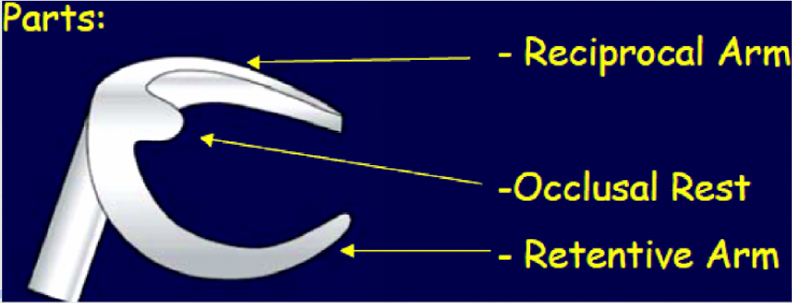
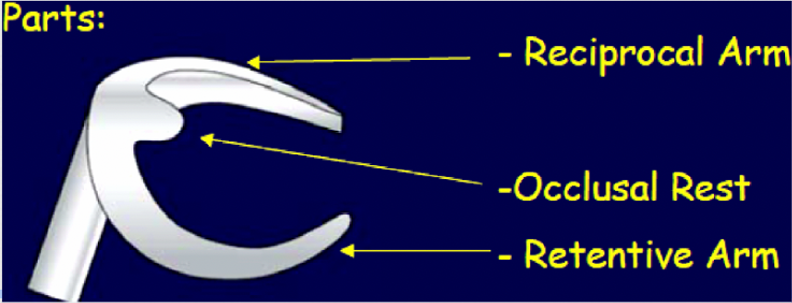
what is clasp assembly?
part of RPD that act as a direct retainer and/or stabiliser for the prosthesis by partially encompassing or contacting an abutment tooth
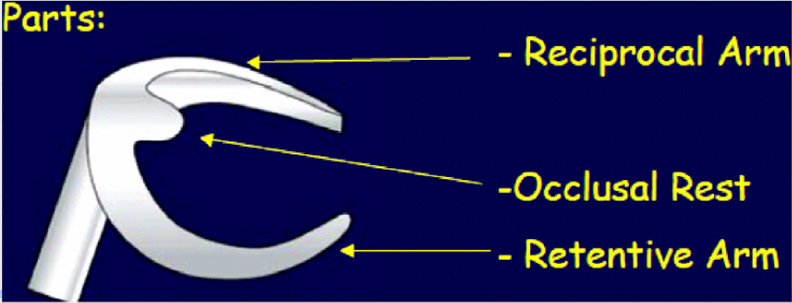
what are components of clasp assembly?
clasp
reciprocal clasp
cingulum
incisal or occlusal rest
minor connector

what is a clasp?
component of clasp assembly
engages a portion of the tooth surface and either enters an undercut for retention or remains entirely above the height of contour to act as reciprocating element
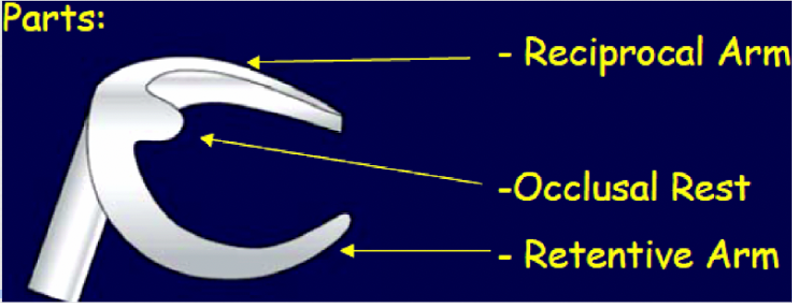
what is the component of clasp assembly called that frequently enters an undercut for retention?
retentive clasp arm
what is the component of clasp assembly called that provides reciprocation by engaging reciprocal guiding planes?
reciprocal clasp arm
(provides action of clasp during removal and insertion of partial removable dental prosthesis)
what is occlusal rest?
rigid extension of a partial removable dental prosthesis that contacts the occlusal surface of a tooth or restoration
occlusal surface which may have been prepared to receive it
modifications - incisal, lingual and cingulum rest
what is a rest seat?
prepared recess in a tooth or restoration created to receive the occlusal, incisal, cingulum or lingual rest
what is occlusal rest arm?
minor connector used to attach an occlusal rest to a major part of a removable partial denture
what is an undercut?
portion of surface of an object that is below the hight of contour (biggest contour) in relationship to path of insertion
what is a surveyor?
instrument used in construction of a dental prosthesis to locate and delineate the contour and relative positions of abutment teeth and associated structures
what is survey line?
line produced on cast by surveyor marking the greatest prominence of contour in relation to the planned path or placement of a restoration (prosthetic equator)
what is path of placement?
specific direction in which the prosthesis is placed on the abutment teeth or dental implant(s) (also called path or insertion or withdrawal)
what are the requirements of direct retainers in order to function effectively and not harm abutment teeth or tissue of denture foundation area?
support
retention
cross-tooth reciprocation
fixation
passivity
how does a clasp assembly provide support?
positive contact of rest (component of clasp assembly) with tooth prep
Proper contact between clasp assembly and abutment tooth ensures retention
distinguish clasp assembly and attachment
clasp assembly: provides retention by engaging undercuts of teeth
attachment: connect removable prostheses to natural teeth or implants
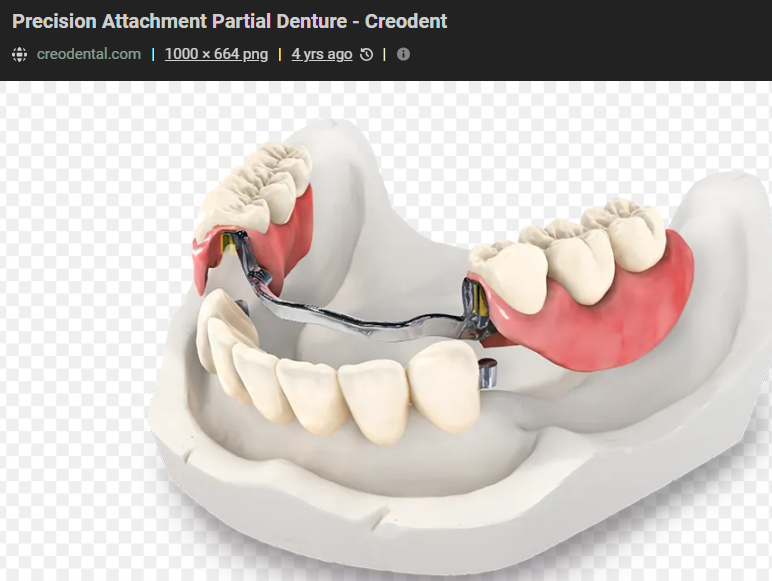
How does attachment provide support?
Through contact between a rigid element on denture and rigid element on abutment teeth
How does clasp assembly provide retention?
by resistance of flexure by the retentive clasp engaging height of contour of tooth as RPD moves occlusally/incisally
Frictional contact of rigid portions (proximal minor connectors and reciprocal component
Tooth surfaces parallel to path of insertion can also contribute to retention
how does attachment provide retention?
Frictional contact of long parallel walls of attachment
Mechanical locking devices
Resistance to deformation of resilient locking materials
Retentive clasp arms on lingual surface of abutment can frequently provide or supplement retention for attachments
what is reciprocation?
occurs when lateral forces from a retentive clasp are counterbalanced by a reciprocal component
how does clasp assembly provide reciprocation?
reciprocal component contacts the tooth on opposite side of retentive clasp arm, stabilising the tooth and negating the force
how does attachment provide cross-tooth reciprocation?
precise fit of long parallel walls or supplemental reciprocal components
what is cross-tooth recirpocation?
In RPD, every force exerted by direct retainer on one side of arch is counterbalanced by an equal and opposite force on an abutment tooth on opposite side
ensures balance and stability in RPD
what is fixation?
resistance to movement of abutment tooth away from prosthesis and vice versa
how does clasp assembly provide fixation?
encompass or encircle at least 180 degrees of abutment tooths circumference
also called encirclement
how does attachment provide fixation?
dovetail or circular design of component parts
supplemental clasp arms on lingual or abutment tooth
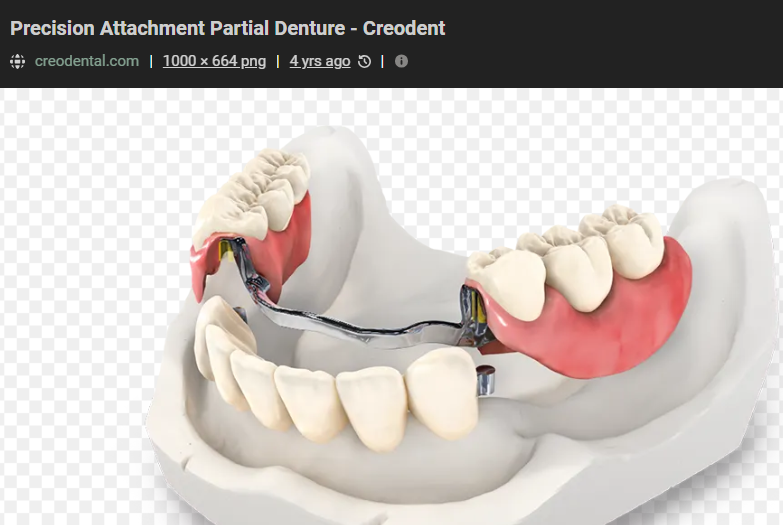
what is Passivity in direct retainers?
DR should not exert forces on abutment teeth when RPD is seated
should be passive during RPD seating, forces should only occur during insertion ro removal
what is the importance of passivity?
ensures that clasp is completely seated and retention clasp arm is not active
Helps maintain stability and comfort of RPD
what are the types of Direct retainers?
intracoronal retainer (in crown)
Extracoronal retainer (outside of crown, most commonly used)
Intracoronal retainer
cast or attached totally within restored natural contours of abutment tooth
which is composed of prefabricated machine key and keyway with opposing vertical walls
(which serve to limit movement and resist removal of partial denture through friction)
Usually regarded as internal/precision attachment
Principle of internal attachment first formulated by Dr Herman E.S Chayes in 1906
Extracoronal retainer
uses mechanical resistance to displacement through components on external surface of abutments
Three principle forms:
clasp-type retainer
manufactured attachment
dental implant
Clasp-type retainer is most common, retains through flexible clasp arm
Manufactured attachment uses flexible clips or rings, engaging rigid component on abutments
Dental implants used for retention, eliminating visible clasps
what should be considered when designing extracoronal retainer?
function and location
retainer should provide:
support
stabilisation
reciprocation
retention
Retainer-clasp assembly components can be physically attached or originate from major and minor connectors
what are the 4 component parts of clasp assembly?
minor connector
principle rest
retentive arm
non-retentive arm
minor connector
one or more minor connector should be present , from which clasp components originate
principle rest
should be designed to direct stress along long axis of tooth
retentive arm
engage tooth undercut
for most clasps, retentive region is only at its terminus (at the end of clasps)
non-retentive arm
should be present on opposite side of tooth compared to retentive arm
Provides stabilisation and reciprocation against horizontal movement of prosthesis
Rigidity of this clasp arm is essential
what are the different types of clasp assemblies and what do they stand for?
RPI - rest, proximal plate (minor connector), I bar (ideal class II lever system)
RPA - rest proximal plate (minor connector), Akers clasp
RPC - rest, proximal plate (minor connector), circumferential clasp (same as one above)
How do RPI,RPA and bar class mesial rest concept clasps accommodate movement?
by changing fulcrum location
Commonly used are RPI and RPA clasps
which type of clasp arms are commonly used for RPI and RPA clasps?
T and Y
It is not necessary to have the full area of T or Y terminal for adequate clasp retention.
Only portion of clasp engaging the undercut area
Large area of contact provides greater frictional resistance, does not guarantee true clasp retention
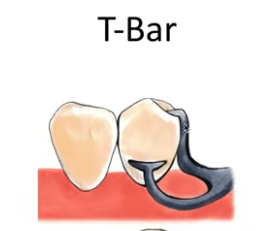
It is not necessary to have the full area of T or Y terminal for adequate clasp retention.
Only portion of clasp engaging the undercut area
Large area of contact provides greater frictional resistance, does not guarantee true clasp retention
It is not necessary to have the full area of T or Y terminal for adequate clasp retention.
Only portion of clasp engaging the undercut area
Large area of contact provides greater frictional resistance, does not guarantee true clasp retention
remainder of clasp arms (T and Y ) are superfluous (excessive) unless?
it is needed to encircle abutment tooth by more than 180 degrees at its greatest circumference
types of bar clasp?
T bar
Modified T bar
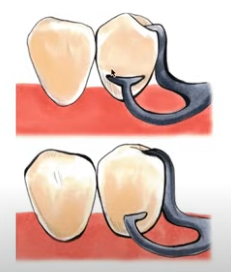
If the bar arm is flexible (for retentive purpose), why would any portion of clasp above height of contour provide only limited stabilisation?
because it is also part of flexible arm
Therefore, in many instances, this suprabulge portion of T or Y clasp arm may be removed (part not engaging undercut for retention) and retentive terminal (end of T or Y bar clasps) should be designed to be biologically and mechanically sound rather than to conform to any alphabetical configuration
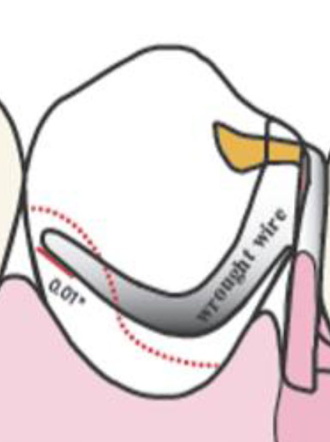
what is combination clasps?
made up of two components:
wrought wire retentive clasp arm
cast reciprocal clasp arm
It offers balance between retention and stability
Allows for secure fit of RPD
ideal for abutments adjacent to distal extension bases
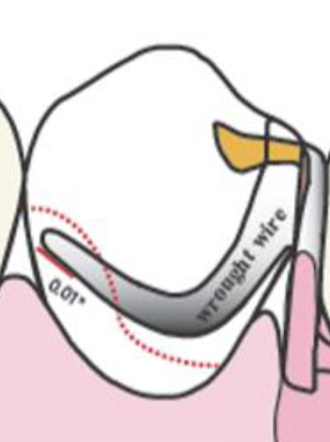
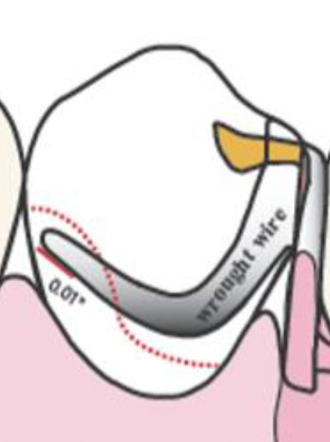
describe retentive clasp arm of combination clasps
tapered, round wrought-wire
provides retention by flexing and gripping onto tooth or abutment
Typically attached to cast framework by casting or soldering (added on, not part of one unit of claps assembly)

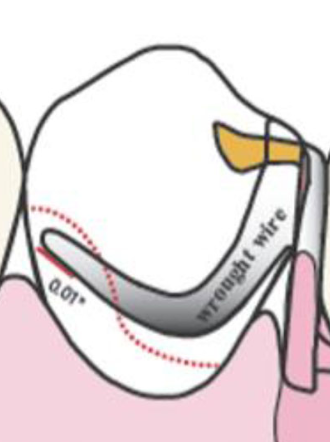
describe reciprocal clasp assembly of combination clasps
made of cast metal
serves as counterpart to retentive clasp arm
engages with undercut area of abutment tooth
Provides stability and support to RPDs
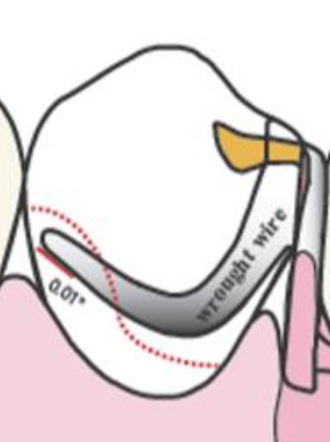
Type A clasp
distobuccal undercut engaged by one-half T-type bar clasp
Portion of clasp arm on and above height of contour offers some stabilisation against horizontal rotation of denture bases
what type of clasp are bar clasps?
infrabulge
approaches undercut from below the survey line
examples - T type clasp, I type clasp
Type B clasps
I bar placed in undercut (infrabulge) of buccal surface
Retainer contacts tooth only at its tips
Guiding plane on distal aspect of abutment is contacted by the metal or denture framework
Mesial rest is used
Guiding planes are parallel surfaces on abutment teeth that help direct the placement and removal of a removable partial denture
Type C clasps
Interproximal ring clasp engaging the distobuccal undercuts
Bar-type retainer cannot be used cause of tissue undercuts inferior to buccal surface of abutment
Interproximal refers to the area between adjacent teeth
Type D clasp
Round, uniformly tapered 18-gauge wrought wire circumferential retainer arm engaging the mesiobuccal under cut
Wrought wire used instead of cast arm because of ability of wrought wire to flex omnidirectionally
omnidirectionally refers to movement occurring in all directions simultaneously
Type E clasp
Hair pin (back action clasp) and interproximal ring clasp (embrasure clasp) are least desirable of the alphabet classifications of clasp types
Hair pin is useful when undercut is located below point where clasp arm starts
Both hairpin and interproximal ring clasps can engage distobuccal undercuts of terminal abutment teeth (posterior abutment teeth) in distal extension cases
If no significant tissue undercut near gumline, use bar-type clasp instead of engaging distobuccal undercut
Basically: Use a hairpin or ring clasp when necessary, but opt for a bar clasp if there's no large tissue obstruction
Type F clasps
Lingual view shows use of double occlusal rest (connected to lingual bar by minor connector)
Design eliminates need for lingual clasp arm
Places fulcrum line anteriorly to make better use of residual ridge for support and provide stabilisation against horizontal rotation of denture base
what are circumferential clasps?
clasps designed without movement accommodation
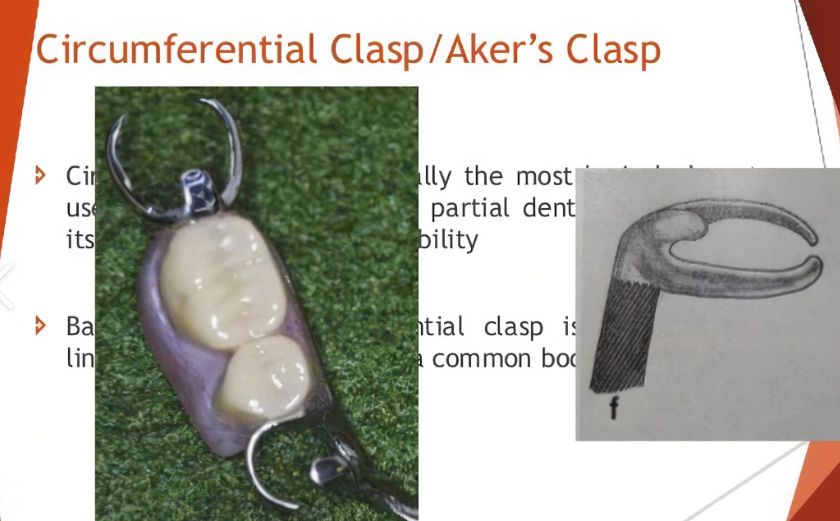
describe circumferential clasp
often used with tooth-supported partial dentures
provides retention and stabilisation
considered a logical choice due to effectiveness
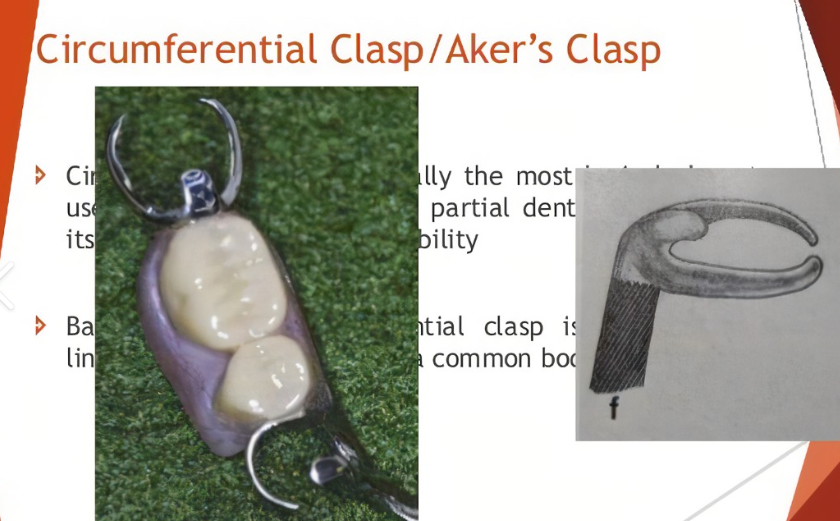

what does the basic form of circumferential clasp consist of?
consists of buccal and lingual arm originating from common body
most logical clasp choice for tooth-supported partial denture due to its retentive and stabilising ability
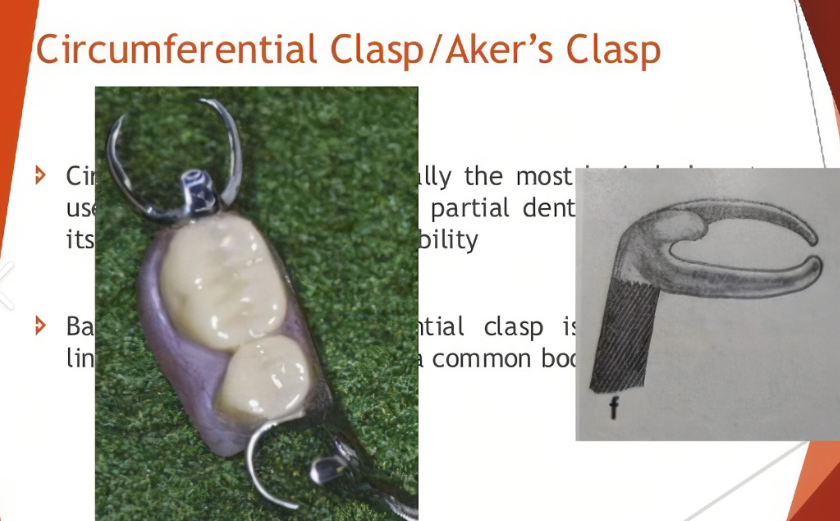
Improper use of circumferential clasp
when two retentive clasp arms originate from body and occlusal rest areas, approaching bilateral retentive areas on opposite side of tooth from point of origin
what is the correct form of circumferential clasp?
one retentive clasp arm, opposed by non-retentive reciprocal arm on opposite side
how are disadvantages of circumferential clasps minimised?
proper mouth preparation
what does mouth preparation entail for circumferential clasps?
adequate prep allows for proper placement of clasp’s point of origin below the occlusal surface
Helps avoid poor aesthetics and increased tooth dimensions
what are the types of ring clasps?
ring clasp
embrasure clasp
embrasure and hairpin clasp (interproximal and hair pin clasp)
Ring clasp
encircles nearly all of tooth from its point of origin
Used when a proximal undercut cannot be approached by other means
proximal undercut refers to a retentive area located on the proximal surface of a tooth—meaning the surface that faces an adjacent tooth. They provide mechanical retention for clasps and other retentive components.
Embrasure clasp
In Class II and III partial denture, no edentulous space available on opposite side to help in clasping
This is a disadvantage mechanically
Embrasure clasp can be used if:
teeth and sound
retentive areas are available
multiple restorations are justified
Embrasure and Hairpin clasp
Sufficient space between abutment teeth in occlusal third for common body of embrasure clasp
Historically, embrasure class shows high levels of fractures due to inadequate tooth prep in contact area
Embrasure should always be used with double occlusal rest, to avoid interproximal wedging by prosthesis (can cause separation of abutments leading to food entrapment and clasp displacement)
Occlusal rests shunt food away from contact areas, so should always be used when food impaction is possible
Embrasure clasps have tow retentive clasp arms and two reciprocal clasp arms that are bilaterally and diagonally opposed
what are the types of clasp modifications?
back action clasp
multiple clasp
half-and-half clasp
reverse-action clasp
back-action clasp
modification of ring clasp
same disadvantages and no apparent advantages
Use is difficult to justify
- limited flexibility, potential plaque accumulation, stress on abutment tooth
+ good retention, stable support, ideal for engaging undercuts on same side of tooth
what should an occlusal rest ALWAYS be attached to?
some minor connect and should never be supported by clasp arm alone
If occlusal rest is part of flexible assembly, it cannot function adequately as an occlusal rest
Multiple clasp
consists of two opposing circumferential clasps joined at terminal end of two reciprocal arms
Used when additional retention and stabilisation needed
May be used for multiple clasping in instances in which partial denture replaces an entire half of dental arch
May be used rather than embrasure clasp when the only available retentive areas re adjacent to each other
- two embrasure approaches are necessary rather than a single common embrasure for both clasps
Half-and-half clasp
consists of circumferential retentive arm arising from one direction and reciprocal arm arising from another
Second arm must arise from minor connector, this arm used with or without auxiliary occlusal rest
Reciprocation arising from second minor connector usually accomplished with short bar or auxiliary occlusal rest , thereby avoiding so much tooth coverage
Little use of half and half clasp in bilateral extension ad it was originally designed to be used for unilateral partial denture design
reverse-action clasp
also called hairpin clasp arm
designed to allow proximal undercut to be engaged from an occlusal approach
what is the principle pf design of direct retainers by Ney system?
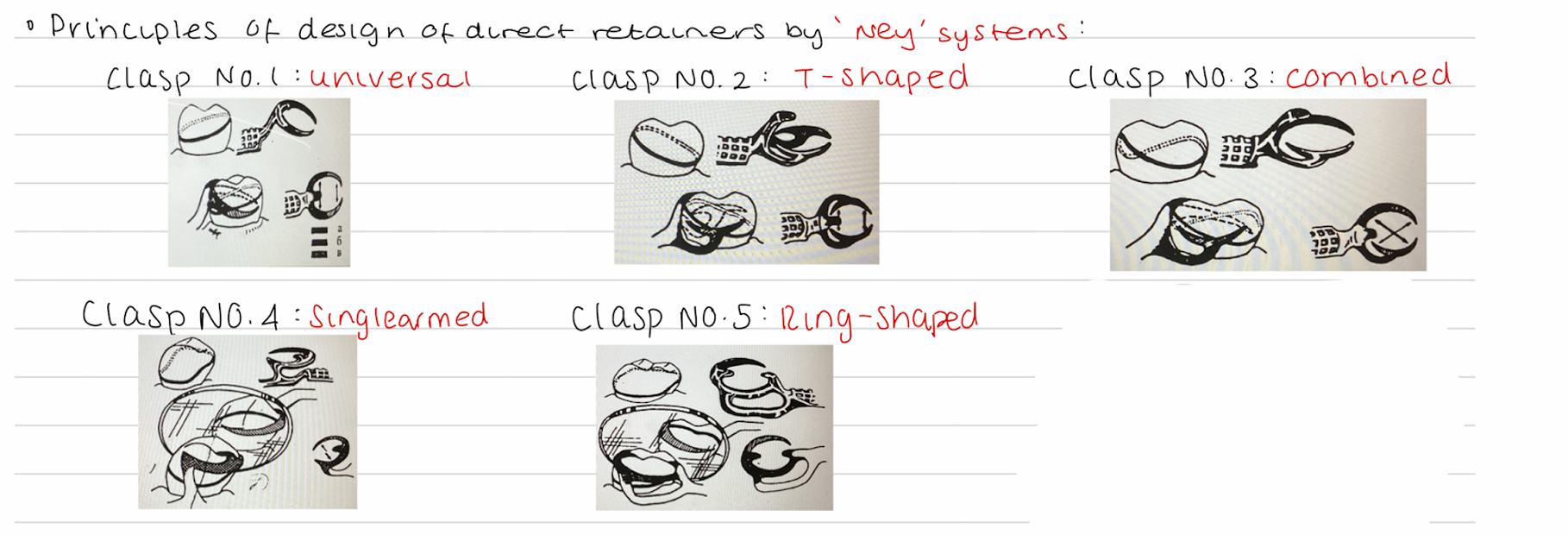
what are general characterisations of Ney clasp system?
all have occlusal arms, transferring occlusal forces to so called “physiological way”
support and reciprocal arms are rigid, nonelastic and situated in suprabulge
retention arms are elastic situated in infrabulge
clasp assembly is monolithically connected to denture framework, they are planned, modeled and casted simulatensouly
All clasps united together, through metal framework and acts and one complex, concerning both: denture, dentition and soft tissues
what is the purpose of surveying?
identify most favorable tilt
retentive undercuts
interferences
path of insertion
recoridng position of cast
measuring retention
recoridng prosthetic equator
what is resistance arm?
length of lever from fulcrum to resistance
what is effort arm?
portion of lever from fulcrum to point of application of force
longer than resistance arm = advantage